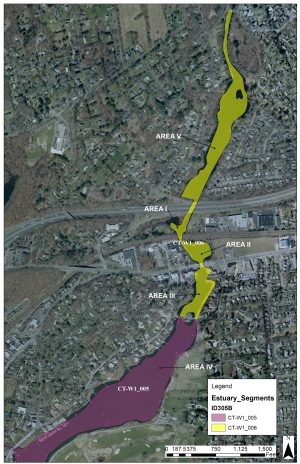Mill River Estuary (Fairfield, CT) Water Quality
The estuarine portion of the Mill River in Fairfield, CT, consists of two water body segments:- Segment CT-W1_005 is located from the mouth of Southport Harbor (parallel to Willow Street) upstream to Harbor Road in Fairfield
- Segment CT-W1_006 begins at the Harbor Road crossing on the Mill River and continues upstream to the Sturges Road crossing of the river
 These estuarine segments are classified as Class SA surface waterbodies. In accordance with the Connecticut Water Quality Standards, Class SA waterbodies, should support a healthy aquatic and wildlife community, recreational activities and be a resource for fishing and shellfishing.
These estuarine segments are classified as Class SA surface waterbodies. In accordance with the Connecticut Water Quality Standards, Class SA waterbodies, should support a healthy aquatic and wildlife community, recreational activities and be a resource for fishing and shellfishing. Previously, these segments were impaired for aquatic life and recreational uses due to chromium and lead in sediment. In 2020, CTDEEP obtained data to remove the chromium and lead in sediment impairments for both of these uses for CT-W1_006 as a result of restoration activities through a Remedial Action Plan.
As a result of these remedial activities, the Department of Public Health has removed the "Do Not Eat" advisory for Blue Crabmeat from the Mill River because lead levels in crabmeat are below the site-specific lead concentration target and at or below background levels in unimpacted areas of the Mill River.
However, segment CT-W1-006 remains on the "Do Not Eat " advisory for Blue Crab tomalley due to elevated levels of lead (described below).
The consumption advisory is consistent with the "Do Not Eat advisory for lobster tomalley from Long Island Sound.
Elevated Bacteria
Shellfishing impairments within Southport Harbor (CT-W1_005 and CT-W1_006) are due to elevated concentrations of bacteria (fecal coliform). A TMDL for the Mill River (CT-W1_005) has been established by CTDEEP and approved by EPA to identify potential sources of bacteria, and has set pollution load reductions necessary to restore shellfishing activities. As of 2022, This segment remains impaired for shellfishing, it is unassessed for recreational use and is meeting Water Quality Standards for aquatic life use support. Segment CT-W1_006 has been identified for TMDL development for shellfishing (fecal coliform). For changes in assessment status and TMDL development please refer to the Integrated Water Quality Report which is submitted biannually.
- Statewide Bacteria TMDL
- Estuary 4: Westport-Fairfield (CT-W1_005)
- CT Water Quality Standards
- 2012 Integrated Water Quality Report
Lead Contamination
The lead contamination within the Mill River was evaluated as part of human and ecological risk assessments conducted by the Exide Group Incorporated, as required by CT DEEP. Risk assessments have shown that lead in the sediments is impacting the recreational use of the river due to risks from direct contact with sediments containing lead, as well as accumulation into fish and shellfish tissues, which could pose a risk to people who might eat the fish and shellfish.
In response to the contamination, a consumption advisory has been established recommending that people not eat Blue Crab tomalley from the Mill River estuary. The risk assessments also demonstrated that the aquatic life and avian communities were at risk, due to exposure to lead.
In 2022, DEEP staff collected Blue Crab from lower Mill River and analyzed the tissue and hepatopancreas ("tomalley") for lead. The results of this effort indicate that lead levels have declined in Blue Crabmeat since the advisory was first issued. To learn more visit the Aquatic Tissue Contaminant Monitoring Project webpage.
Remediation of the Former Exide Battery Manufacturing Site
Chromium Contamination
DEEP continues to work with Superior Plating Company to mitigate the migration of chromium into the Mill River. Dredging of lead-contaminated sediments (see "Lead Contamination" section) is likely to have removed chromium-impacted sediment. Superior Plating Company currently maintains and monitors a hydraulic system to contain chromium contaminated groundwater to their site.

